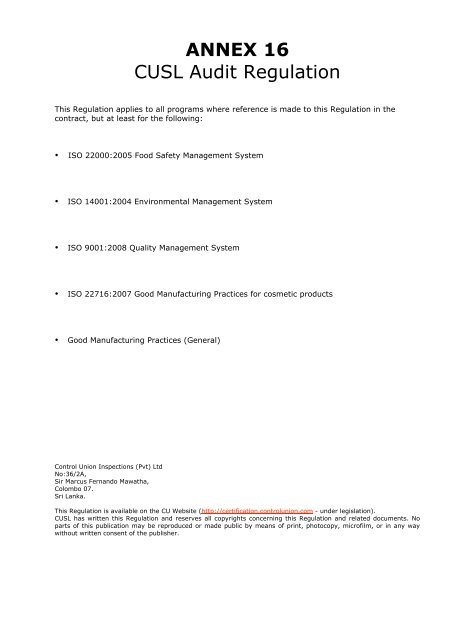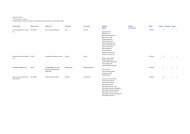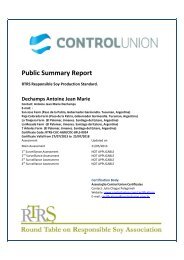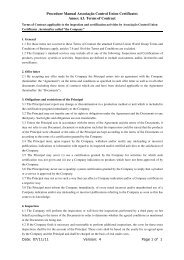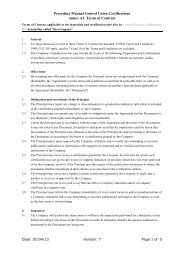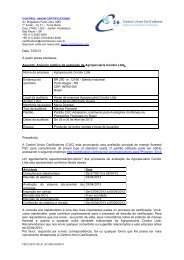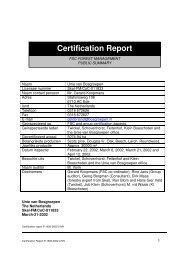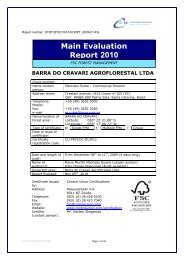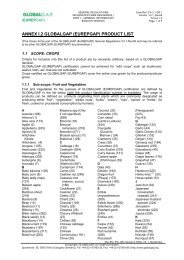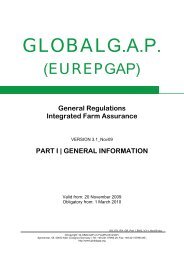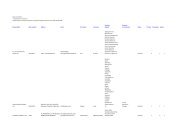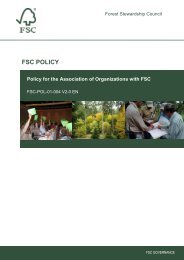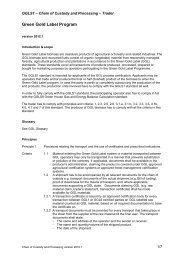ANNEX 16 CUSL Audit Regulation - Control Union
ANNEX 16 CUSL Audit Regulation - Control Union
ANNEX 16 CUSL Audit Regulation - Control Union
You also want an ePaper? Increase the reach of your titles
YUMPU automatically turns print PDFs into web optimized ePapers that Google loves.
<strong>ANNEX</strong> <strong>16</strong><br />
<strong>CUSL</strong> <strong>Audit</strong> <strong>Regulation</strong><br />
This <strong>Regulation</strong> applies to all programs where reference is made to this <strong>Regulation</strong> in the<br />
contract, but at least for the following:<br />
• ISO 22000:2005 Food Safety Management System<br />
• ISO 14001:2004 Environmental Management System<br />
• ISO 9001:2008 Quality Management System<br />
• ISO 227<strong>16</strong>:2007 Good Manufacturing Practices for cosmetic products<br />
• Good Manufacturing Practices (General)<br />
<strong>Control</strong> <strong>Union</strong> Inspections (Pvt) Ltd<br />
No:36/2A,<br />
Sir Marcus Fernando Mawatha,<br />
Colombo 07.<br />
Sri Lanka.<br />
This <strong>Regulation</strong> is available on the CU Website (http://certification.controlunion.com - under legislation).<br />
<strong>CUSL</strong> has written this <strong>Regulation</strong> and reserves all copyrights concerning this <strong>Regulation</strong> and related documents. No<br />
parts of this publication may be reproduced or made public by means of print, photocopy, microfilm, or in any way<br />
without written consent of the publisher.
<strong>CUSL</strong> <strong>Audit</strong> <strong>Regulation</strong><br />
Introduction and Scope<br />
This <strong>Audit</strong> <strong>Regulation</strong> contains regulation regarding the policy of <strong>Control</strong> <strong>Union</strong> Inspections<br />
(Pvt) Ltd (<strong>CUSL</strong>) on <strong>Audit</strong> and certification. It mentions what your rights and obligations are,<br />
as well as those of <strong>CUSL</strong>. It also mentions additional rules for specific programs. It contains<br />
contract related regulation as well. In this sense the <strong>Audit</strong> <strong>Regulation</strong> is complementary to the<br />
applicable standards, the offer letter, as well as the Terms of Contract. Please refer to the<br />
structure diagram below.<br />
<strong>CUSL</strong> <strong>Audit</strong> <strong>Regulation</strong><br />
Version 13.SL.02; 2013 JAN<br />
Pointing to the relevant documents:<br />
1.<br />
2.<br />
3.<br />
Contract for<br />
<strong>Audit</strong> and/or<br />
certification<br />
Terms of<br />
contract<br />
Applicable<br />
legislation/standards<br />
<strong>CUSL</strong> <strong>Audit</strong><br />
<strong>Regulation</strong><br />
2
The <strong>Audit</strong> <strong>Regulation</strong> contains general rules that are applicable for all clients<br />
concerned and contains the following paragraphs:<br />
1. Applicability<br />
2. Definitions<br />
3. <strong>Audit</strong><br />
4. <strong>Audit</strong> report<br />
5. Certification<br />
6. Certificates<br />
7. Use of indications and symbols<br />
8. Appeals and complaints<br />
9. Final provisions<br />
10. Policy of taking over projects certified by other certification bodies.<br />
In every sentence where the singular form is in a context, the plural form should be supposed.<br />
This is also the case for male and female word expressions.<br />
<strong>CUSL</strong> <strong>Audit</strong> <strong>Regulation</strong><br />
Version 13.SL.02; 2013 JAN<br />
3
Table of Content<br />
Introduction and Scope .......................................................................................... 2 <br />
Table of Content ..................................................................................................... 4 <br />
1 Requirements for <strong>Audit</strong> and Certification .......................................................... 5 <br />
1.1 Applicability ..................................................................................................... 5 <br />
Article 1 Applicability ..................................................................................... 5 <br />
1.2 Definitions........................................................................................................ 5 <br />
Article 2 Definitions ........................................................................................ 5 <br />
1.3 <strong>Audit</strong> 8 <br />
Article 3 Conditions for <strong>Audit</strong> ........................................................................... 8 <br />
Article 4 <strong>Audit</strong>or ............................................................................................ 8 <br />
Article 5 <strong>Audit</strong> ............................................................................................... 8 <br />
Article 5a Subject of evaluation ......................................................................... 8 <br />
Article 5b Method of evaluation/<strong>Audit</strong>................................................................. 8 <br />
Article 5c <strong>Audit</strong> types: ..................................................................................... 9 <br />
Article 5d Classification of non-conformities......................................................... 9 <br />
Article 5e Sanction and condition of granting certification .................................... 10 <br />
Article 5f Guidelines for closing a non-conformity .............................................. 10 <br />
Article 6 Samples ........................................................................................ 12 <br />
Article 7 Register complaints and remedial actions............................................ 12 <br />
Article 8 Responsibility and Liability................................................................ 12 <br />
1.4 <strong>Audit</strong> report.................................................................................................... 12 <br />
Article 9 <strong>Audit</strong> report .................................................................................... 12 <br />
1.5 Certification.................................................................................................... 12 <br />
Article 10 Certification.................................................................................... 12 <br />
1.6 Certificates ..................................................................................................... 13 <br />
Article 11 Scope Certificate............................................................................. 13 <br />
Article 11.a Possible certification decisions of the certifier..................................... 13 <br />
Article 12 Invalidity and duplicates of certificates............................................... 14 <br />
Article 13 Accreditation .................................................................................. 14 <br />
1.7 Use of indications and symbols ...................................................................... 15 <br />
Article 14 Use of indications and symbols......................................................... 15 <br />
1.8 Appeals/Complaints ....................................................................................... 15 <br />
Article 15 Appeals/Complaints......................................................................... 15 <br />
1.9 Final provisions .............................................................................................. 15 <br />
Article <strong>16</strong> Documents and publication............................................................... 15 <br />
Article 17 Cases not covered by this <strong>Regulation</strong> ................................................. <strong>16</strong> <br />
1.10 Policy on taking over projects from other certification bodies ................ <strong>16</strong> <br />
Article 18 Taking over projects from other certification bodies ............................. <strong>16</strong> <br />
<strong>ANNEX</strong> 1 Complaint Form .................................................................................... 17 <br />
<strong>ANNEX</strong> 2 Conditions for publication and use of the Certification Logo ................. 19 <br />
<br />
<strong>CUSL</strong> <strong>Audit</strong> <strong>Regulation</strong><br />
Version 13.SL.02; 2013 JAN<br />
4
1 Requirements for <strong>Audit</strong> and Certification <br />
1.1 Applicability<br />
Article 1 Applicability<br />
1. This <strong>Regulation</strong> has been adopted by the Managing Director of the <strong>Control</strong> <strong>Union</strong><br />
Inspections (Pvt) Ltd (<strong>CUSL</strong>) on 1 January 2010, and can be referred to as <strong>CUSL</strong> <strong>Audit</strong><br />
<strong>Regulation</strong>.<br />
2. The Managing Director <strong>CUSL</strong> has the right to change or extend this <strong>Regulation</strong> by<br />
amendments. The amendments shall be highlighted in italics.<br />
3. The <strong>CUSL</strong> <strong>Audit</strong> <strong>Regulation</strong> and the amendments shall be published within one month<br />
after the Managing Director <strong>CUSL</strong> has adopted them.<br />
4. For any change or extension of this <strong>Regulation</strong>, a transition period is given. In all cases<br />
where no transition period for the individual amendment is given, a transition period of<br />
three months after the adoption will apply.<br />
5. The <strong>CUSL</strong> <strong>Audit</strong> <strong>Regulation</strong> is applicable for all programs mentioned in ”Introduction and<br />
Scope”.<br />
6. In any case where conflicting rules in both the client contract and the <strong>CUSL</strong> <strong>Audit</strong><br />
<strong>Regulation</strong> are encountered, the client contract shall overrule the <strong>CUSL</strong> <strong>Audit</strong> <strong>Regulation</strong>.<br />
7. <strong>Control</strong> <strong>Union</strong> Inspections (Pvt) Ltd commits itself to conduct its activities impartially and<br />
in a professional manner. <strong>CUSL</strong> understands the importance of impartiality in carrying<br />
out its certification activities, managing conflicts of interest and ensuring the objectivity<br />
of its management system certification activities.<br />
1.2 Definitions<br />
Article 2 Definitions<br />
This document adopts all definitions as defined by:<br />
- General requirements for bodies operating product certification systems (ISO/IEC<br />
Guide 65: 1996 – EN45011)<br />
- ISO 9001:2008, ISO 9000, ISO 19011, ISO 17021<br />
- ISO 22000:2005, ISO 22003:2007<br />
- ISO 14001:2004<br />
- ISO 227<strong>16</strong>:2007<br />
- GMP (General)<br />
This document uses the following additional definitions:<br />
• Appeal An appeal is a disagreement with a certification decision of<br />
<strong>Control</strong> <strong>Union</strong> Inspections (Pvt) Ltd by a client.<br />
• <strong>Audit</strong> A systematic assessment to substantiate whether<br />
activities and related results comply with the planned<br />
arrangements and whether these arrangements are<br />
implemented effectively and are suitable to achieve<br />
objectives.<br />
• <strong>Audit</strong>or A person who carries out an audit. <strong>Audit</strong>or is responsible<br />
for the reporting to the Program Manager or Certifier.<br />
• Certification An action by a party (in this case: the certification body,<br />
<strong>CUSL</strong>) to confirm there is satisfactory confidence that a<br />
sufficiently identified product, process or activity is in<br />
conformity with a standard, regulation or rule.<br />
• Certification body A body that conducts certification of conformity.<br />
<strong>CUSL</strong> <strong>Audit</strong> <strong>Regulation</strong><br />
Version 13.SL.02; 2013 JAN<br />
5
• Certification program A system (or program) that has its own procedure and<br />
management for carrying out certification of conformity.<br />
• Certifier A person who, under supervision of the Program Manager,<br />
is responsible for marketing of the program, instructions<br />
to the (Senior) <strong>Audit</strong>or/<strong>Audit</strong>or, certification decision,<br />
reporting to the client, issuance of certificates, customer<br />
relations and post certification activities.<br />
• Client A contract partner of <strong>CUSL</strong> for <strong>Audit</strong> and certification<br />
programs, with the aim of being inspected and certified.<br />
• Client contract A written agreement between <strong>CUSL</strong> and the client<br />
concerning all rights and duties concerning a <strong>CUSL</strong><br />
certification program. The client contract does not indicate<br />
that the client is certified.<br />
• Client number A unique number that <strong>CUSL</strong> provides the client to identify<br />
himself as a <strong>CUSL</strong> client. The client number does not<br />
indicate that the client is certified.<br />
• Complaint A formal expression of dissatisfaction by any person or<br />
organization to <strong>Control</strong> <strong>Union</strong> Certifications.<br />
• <strong>CUSL</strong> branch office <strong>CUSL</strong> office that is legally entitled to represent <strong>CUSL</strong>.<br />
• <strong>CUSL</strong> office <strong>CUSL</strong> office situated in Colombo in Sri Lanka, where<br />
development and maintenance of <strong>Audit</strong> and certification<br />
programs takes place.<br />
• Evaluation A systematic assessment of the extent to which a system,<br />
product, process or service fulfills a specific requirement.<br />
• Non-conformity A deviation from specified requirements, or the failure to<br />
maintain one or more required management system<br />
elements.<br />
• Processing unit A company or company unit where actions are carried out<br />
defined under “preparation” in the distinct normative<br />
documents.<br />
• Product specification A declaration in which a producer / processor specifies all<br />
ingredients in the product concerned.<br />
• Production unit A company or company unit where actions are carried out<br />
defined under “production” in <strong>Regulation</strong> (EEC) No.<br />
834/2007 and 889/2008. Also mentioned agricultural<br />
units or farmers units (for organic production) or forestry<br />
management units (for forestry).<br />
• Program Manager A person who is responsible for the development and<br />
maintenance of a certification program and quality<br />
systems.<br />
• Scope Certificate A document issued under the rules of a certification<br />
system, demonstrating that adequate confidence is<br />
<strong>CUSL</strong> <strong>Audit</strong> <strong>Regulation</strong><br />
Version 13.SL.02; 2013 JAN<br />
6
<strong>CUSL</strong> <strong>Audit</strong> <strong>Regulation</strong><br />
Version 13.SL.02; 2013 JAN<br />
provided that a duly identified product, process or service<br />
is in conformity with a specific standard or other<br />
normative document.<br />
• Smallholder farmer group A farmer group as described in the concerning chapters.<br />
• Source The location where the product comes from.<br />
• Standard A document established by <strong>CUSL</strong> or any other body that<br />
provides rules and requirements for activities or their<br />
results.<br />
• SLAB Sri Lanka Accreditation Board<br />
7
1.3 <strong>Audit</strong><br />
Article 3 Conditions for <strong>Audit</strong><br />
1 By accepting any offer made by <strong>Control</strong> <strong>Union</strong> Inspections (Pvt) Ltd the client enters into<br />
an agreement with <strong>CUSL</strong> on the terms and conditions as specified in such offer letter as<br />
well as in all other documents (including the terms of contract) which are and have been<br />
declared applicable to the Agreement.<br />
2 In the event that it is not possible to carry out the <strong>Audit</strong> at a relevant time because of<br />
delayed payment, <strong>CUSL</strong> has the right to postpone or cancel the <strong>Audit</strong> and certification.<br />
3 In the event that it is not possible to carry out the <strong>Audit</strong> due to safety issues (e.g. in the<br />
event of unforeseen natural disasters or political instability), <strong>CUSL</strong> has the right to<br />
postpone or cancel the <strong>Audit</strong> and certification. The decision is among others based on<br />
internationally (e.g. official statements of ministry of Dutch foreign affairs) and locally<br />
available information. If the <strong>Audit</strong> is cancelled, <strong>CUSL</strong> shall inform the client as soon as<br />
possible. <strong>CUSL</strong> shall decide on a case-by-case basis whether the certification can take<br />
place on the basis of other information or the certification has to be cancelled.<br />
4 If the objectivity of the <strong>Audit</strong> is compromised, the <strong>Audit</strong>or has the right to abort the <strong>Audit</strong>.<br />
Reasons can be for example the interference of accompanying persons or refusal to grant<br />
access as requested by the <strong>Audit</strong>or. All costs arising from this case are charged to the<br />
client.<br />
Article 4 <strong>Audit</strong>or<br />
1 The <strong>CUSL</strong> <strong>Audit</strong>or shall be able to identify himself with a valid <strong>CUSL</strong> identification card.<br />
2 The <strong>CUSL</strong> <strong>Audit</strong>or shall operate in conformity with the <strong>CUSL</strong> procedures.<br />
3 The <strong>CUSL</strong> <strong>Audit</strong>or shall also respect the <strong>CUSL</strong> Code of Conduct, which is signed by<br />
him/her.<br />
Article 5 <strong>Audit</strong><br />
1 <strong>CUSL</strong> has the right to carry out announced and unannounced <strong>Audit</strong>s. <strong>CUSL</strong> has the right to<br />
carry out additional <strong>Audit</strong> activities for certification purposes and to charge the costs in<br />
addition to the fees as stated in the client contract.<br />
2 <strong>CUSL</strong> has the right to request additional information whenever it believes this to be<br />
necessary to guarantee that the regulations are observed and are verifiable.<br />
3 If requested by <strong>CUSL</strong>, translation services from the local language into a language chosen<br />
by <strong>CUSL</strong> staff shall be provided. <strong>CUSL</strong> shall decide whether <strong>CUSL</strong> or the client shall provide<br />
the <strong>Audit</strong>or translation services. The costs will be charged to the client.<br />
Article 5a Subject of evaluation<br />
1 During the <strong>Audit</strong> performed after the application for a new or changed Certificate, the<br />
requirements for the process of preparation or marketing can be evaluated in a<br />
comparable process. Comparable process can also be defined as preparation or marketing<br />
of the same or comparable conventional product.<br />
2 If a Certificate was granted based on review of the comparable process, the client is<br />
obliged to inform <strong>CUSL</strong> before first processing. <strong>CUSL</strong> may decide to carry out an<br />
additional evaluation.<br />
Article 5b Method of evaluation/<strong>Audit</strong><br />
Evaluation whether the applicable requirements are met can be performed by the following<br />
methods:<br />
1 Administrative evaluation at a <strong>CUSL</strong> Office;<br />
2 Physical and administrative evaluation at the client’s project or elsewhere;<br />
3 Sampling and analysis;<br />
4 Interviews;<br />
5 Cross-checking information received from all of the above.<br />
<strong>CUSL</strong> <strong>Audit</strong> <strong>Regulation</strong><br />
Version 13.SL.02; 2013 JAN<br />
8
Article 5c <strong>Audit</strong> types:<br />
1 Initial audit:<br />
First ever audit of a client for the standard concerned. Initial audit is done if the<br />
client has never been certified for ISO22000, ISO14001, ISO9001, ISO 227<strong>16</strong>,<br />
GMP(General) by CU or by any other company. The initial audit starts with a stage 1<br />
‘audit/document review‘ which is in principle done on-site and continues in a stage 2<br />
‘audit/site visit.’ The stage 2 audit is always an on-site audit.<br />
2 Re-certification audit (re-assessment or re-evaluation):<br />
Done every 3 years after the initial audit or the first time if the client has already<br />
been certified. The re-assessment consists of stage 1 ‘audit/document review’ and a<br />
stage 2 ‘audit/site visit.’ The stage 1 audit is in principle done on-site (but, based on<br />
the situation, PM/Certifier can decide whether stage 1 should be done off-site or onsite),<br />
but the stage 2 audit is always an on-site audit.<br />
3 Surveillance audit:<br />
Yearly follow-up audits between the initial and re-assessment audits. The<br />
surveillance audit has no separate stage 1 and 2 part. The surveillance audit is<br />
always an on-site audit.<br />
In addition the above audit CU can perform special audits.<br />
4 Extensions to scope<br />
CU will in response to an application for extension to the scope of a certification<br />
already granted and undertake a review of the application and determine any audit<br />
activities necessary to decide whether or not the extension may be granted. This<br />
may be conducted in conjunction with a surveillance audit.<br />
5 Short-notice audits<br />
CU reserves the right to conduct short notice audit. These audits are announced to<br />
the client 1 day before the actual visit takes place. The client cannot object against<br />
the audit. The reasons for these short notice audits can be doubts derived from<br />
complaints, external notices or information, internal information gathered during<br />
previous audits or as follow-up on suspension.<br />
6 Re-assessment of non-conformities<br />
Some non-conformities (or a group of non-conformities) may need to be re-assessed<br />
by an additional site visit. The auditor in consultation with the auditee decides when<br />
it is necessary. The certifier can overrule this decision but the client must be<br />
informed.<br />
Article 5d Classification of non-conformities<br />
The ISO22000, ISO14001, ISO9001, ISO227<strong>16</strong> and GMP (General) scheme has<br />
2 NC types:<br />
NC-type Description Deadline<br />
1 Major The absence or the ineffective implementation of one<br />
or more required system elements, or a situation<br />
which raises significant doubt that products or<br />
services will meet the specified requirements. A major<br />
non-conformity can also be a group of minor nonconformities<br />
indicating inadequate implementation of<br />
the system relevant to an element of the standard.<br />
2 Minor A lapse or either discipline or control during the<br />
implementation of the system / procedural<br />
requirements, which does not indicate a system<br />
breakdown or raise doubt that the products or<br />
services will meet the requirements.<br />
1 month;<br />
verification<br />
necessary<br />
3 months;<br />
verification<br />
might be<br />
done<br />
during<br />
next audit.<br />
3 Observations Points not classified as non-conformity during the audit but will be<br />
assessed in the next audit and the aspects that improve the<br />
management system<br />
<strong>CUSL</strong> <strong>Audit</strong> <strong>Regulation</strong><br />
Version 13.SL.02; 2013 JAN<br />
9
Article 5e Sanction and condition of granting certification<br />
Type of Company action Action by CU<br />
non- and<br />
compliance corrective action<br />
1 Major NC Undertake and If more Major NC’s found making obvious the<br />
confirm corrective fundamental deficiencies of the system CU will<br />
action to CU within revisit the company and carry out a full<br />
1 month<br />
assessment.<br />
Initial certification<br />
Certificate cannot be granted unless compliance<br />
is demonstrated with or without a further<br />
revisit. If the corrections are submitted later<br />
than 3 months a complete new audit will take<br />
place.<br />
Re-certification<br />
New certification cannot be granted unless<br />
compliance is demonstrated with or without a<br />
further revisit. Undertake and confirm<br />
corrective action to CU within 1 month.<br />
Suspension of the certificate if NC is not closed<br />
within a month.<br />
Surveillance audits<br />
Undertake and confirm corrective action to the<br />
certification body within 1 month.<br />
Suspension of the certificate if NC is not closed<br />
within a month.<br />
2 Minor NC Undertake and Initial certification<br />
confirm corrective Certification cannot be granted unless<br />
action to CU within compliance is demonstrated with or without a<br />
3 months,<br />
further revisit. If the corrections submitted later<br />
than 3 months a complete new audit will take<br />
place.<br />
Re-certification<br />
New certification cannot be granted unless<br />
compliance is demonstrated with or without a<br />
further revisit. Undertake and confirm<br />
corrective action to the certification body within<br />
3 month.<br />
Suspension of the certificate if NC is not closed<br />
within 3 month.<br />
Surveillance audits<br />
Undertake and confirm corrective action to the<br />
certification body within 3 month. Suspension of<br />
the certificate if NC is not closed within 3<br />
month. Absolute verification of corrective action<br />
can be carried out at subsequent evaluation.<br />
Article 5f Guidelines for closing a non-conformity<br />
1 The client needs to analyze the cause and describe the specific correction and<br />
corrective action taken, or planned to be taken, to eliminate a detected nonconformity<br />
before the above mentioned deadline.<br />
• Corrective action: you need to investigate the non-conformity, determine<br />
the root cause of the problem and implement some form of corrective action<br />
to prevent the problem re-occurring.<br />
<strong>CUSL</strong> <strong>Audit</strong> <strong>Regulation</strong><br />
• Correction: an immediate action to solve the problem without preventing it<br />
Version 13.SL.02; 2013 JAN<br />
re-occurring, a ‘quick-fix’ dealing only with the symptom.<br />
10<br />
Only when the client is sure that the problem has been solved he/she should<br />
submit details of the corrective action along with the evidence of the effectiveness<br />
of the solution and the correction:
• Correction: an immediate action to solve the problem without preventing it<br />
re-occurring, a ‘quick-fix’ dealing only with the symptom.<br />
Only when the client is sure that the problem has been solved he/she should<br />
submit details of the corrective action along with the evidence of the effectiveness<br />
of the solution and the correction:<br />
To do this in the right way the client should ask the following questions:<br />
- Is the root cause of the problem identified.<br />
- Was the problem localized or could it have more far-reaching implications<br />
and are necessary steps taken the to ensure that the corrective action has<br />
been applied through the system where such problems could also occur.<br />
- Has the system been revised so that a permanent fix has been put in place,<br />
not just for the immediate future, but on a more long term basis.<br />
Submitting only a correction is not enough to close a non-conformity.<br />
In your response you need to detail at least the following:<br />
- Explanation of the cause of the failure including root cause.<br />
- Description of measures that has been taken to avoid the reoccurrence of<br />
the problem.<br />
Send evidence that the measures has been implemented.<br />
<strong>CUSL</strong> <strong>Audit</strong> <strong>Regulation</strong><br />
Version 13.SL.02; 2013 JAN<br />
11
Article 6 Samples<br />
1 The <strong>Audit</strong>or has the right to take samples for analysis.<br />
2 When samples are taken, the <strong>Audit</strong>or shall provide the client with a duplicate of the sample<br />
that is taken.<br />
3 <strong>CUSL</strong> shall carry out the analyses on samples by laboratories that are accredited according<br />
to EN 45001 / ISO/IEC 17025 for the applicable matrix and inform the client as soon as the<br />
results are available.<br />
4 If the results of the analyses prove that the applicable regulations are not complied with,<br />
may the results cause changes in the certification.<br />
Article 7 Register complaints and remedial actions<br />
1 The client shall safeguard that all complaints received from: 1. Anyone at any stage of the<br />
project (production- and processing units), 2. customers and/or 3. other third parties, are<br />
centrally registered. The client shall keep records of all received complaints concerning the<br />
certified production method or products and of all remedial actions that are taken to<br />
respond to the individual complaints. Clients must have on location and available on request<br />
a clearly identifiable document for customers complaints. There are documents of the<br />
actions taken with respect to such complaints and any deficiencies found in products or<br />
services. The complaints procedure must ensure that complaints are adequately recorded,<br />
studied and followed up, including a record of actions taken with respect to complaints and<br />
any deficiencies found in products or services.<br />
Article 8 Responsibility and Liability<br />
1 The client is responsible for all production and processing units, products and activities that<br />
are mentioned in the client contract to comply with the applicable standards.<br />
2 The client shall, with regard to the <strong>Audit</strong> and certification activities of <strong>CUSL</strong>, be responsible<br />
for persons who work in or for his business.<br />
1.4 <strong>Audit</strong> report<br />
Article 9 <strong>Audit</strong> report<br />
1 During the <strong>Audit</strong>, the <strong>Audit</strong>or shall record his findings on standardized <strong>Audit</strong> forms. These<br />
forms have to be signed by the client or the official representative of the client during the<br />
<strong>Audit</strong> visit to acknowledge the <strong>Audit</strong>or’s findings. If the official representative signs, his/her<br />
signature is only valid if this person is officially registered as authorized to sign within the<br />
company.<br />
2 The <strong>Audit</strong>or shall provide the certifier with all <strong>Audit</strong> forms with his findings as to the<br />
conformity with all the certification requirements.<br />
3 The findings in the <strong>Audit</strong> forms shall be evaluated and signed by the certifier.<br />
4 After an <strong>Audit</strong> has taken place <strong>CUSL</strong> shall send a summary of the evaluation to the client<br />
without undue delay, moreover conforming to any program specific requirements. The client<br />
has the right to react on the content of the report within a fixed (program specific)<br />
timeframe after sending by <strong>CUSL</strong> (date of postmark). If necessary, the client can ask <strong>CUSL</strong><br />
for an extended period to react.<br />
5 <strong>CUSL</strong> has the right to charge a fee for providing copies of the reports, as well as carry out<br />
other services if the client concerned permits this.<br />
1.5 Certification<br />
Article 10 Certification<br />
1 Based on the certification decision, <strong>CUSL</strong> will issue, update or withdraw the Scope<br />
Certificate.<br />
2 <strong>CUSL</strong> has the right to publish the list of its suspended clients.<br />
<strong>CUSL</strong> <strong>Audit</strong> <strong>Regulation</strong><br />
Version 13.SL.02; 2013 JAN<br />
12
1.6 Certificates<br />
Article 11 Scope Certificate<br />
1 The scope certificate is only valid if signed by the Managing Director of <strong>CUSL</strong> or a person<br />
who has been authorized for it by the managing director.<br />
2 <strong>CUSL</strong> shall renew the scope certificate within the timeframe indicated in the applicable<br />
standards as long as the circumstances are not in conflict with the applicable regulations,<br />
the client contract is continued, and financial liabilities are fulfilled.<br />
3 The client shall keep the valid certificate issued in his records.<br />
4 <strong>CUSL</strong> has the right to request clients to return any certificates (e.g. scope certificates), as<br />
these are legally owned by <strong>CUSL</strong>.<br />
5 <strong>CUSL</strong> shall keep a copy of the scope certificate for authenticity in its records.<br />
6 The scope certificate shall contain an indication of:<br />
- the name and address of the client;<br />
- the client number;<br />
- the certified products and related units;<br />
- the applicable certification program;<br />
- the standards, regulation or other normative documents to which each product,<br />
production unit, or processing unit is certified;<br />
- the effective date of certification and / or place and date of issue of the certificate;<br />
- a hologram;<br />
- any program specific indications applicable.<br />
Article 11.a Possible certification decisions of the certifier<br />
1 Initial certification<br />
Initial certification is when CU certifies the project for the first time. It can be the result of<br />
an initial audit (when the client has not been certified before) or of a re-certification audit<br />
(when the client has already been certified by some other CB). If the decision is positive a<br />
certificate is issued for 3 years. The certificate cannot be issued until it is demonstrated<br />
that the client satisfies all the requirements of the management system standard.<br />
2 Re-certification<br />
After the 3 year audit program is over, there must be a re-certification audit done. Recertification<br />
audit is a complete audit, which is reported in the <strong>Audit</strong> Report. The certifier<br />
shall make decisions on renewing certification based on the results of the re-certification<br />
audit, as well as the results of the review of the system over the period of certification<br />
and complaints received from users of products/services under the scope of certification.<br />
If the decision is positive a new certificate is issued for another 3 years.<br />
3 Maintaining certification (continued certification)<br />
In the frame of the 3 year audit program, between the initial and the re-certification audit<br />
and certification CU must do annual surveillance audits. After each surveillance audit the<br />
auditor reports to the certifier. The certifier shall maintain certification based on<br />
demonstration that the client continues to satisfy the requirements of the management<br />
system standard.<br />
4 Suspension<br />
The certification is suspended in cases when, for example:<br />
- the client's certified management system has persistently or seriously failed to<br />
meet certification requirements, including requirements for the effectiveness of<br />
the management system;<br />
- the certified client does not allow surveillance or re-certification audits to be<br />
conducted at the required frequencies; or<br />
- the certified client has voluntarily requested a suspension;<br />
- certification fee has not been paid;<br />
- non-conformities have not been closed before the deadline;<br />
- failure to comply with other contractual requirements including using the CU<br />
certification marks e.g.: CU ISO22000 logo, ISO14001 logo.<br />
<strong>CUSL</strong> Under <strong>Audit</strong> suspension, <strong>Regulation</strong> the client's management system certification is temporarily invalid.<br />
Version The 13.SL.02; suspended 2013 status JAN of the certification shall be indicated on the publicly accessible<br />
client list. In that case, Client organization shall be informed through a suspension 13 letter.
Under suspension, the client's management system certification is temporarily invalid.<br />
The suspended status of the certification shall be indicated on the publicly accessible<br />
client list. In that case, Client organization shall be informed through a suspension letter.<br />
5 Withdrawal<br />
Suspension can be held for a maximum 6 months. Failure to resolve the issues that have<br />
resulted in the suspension within 6 months shall result in withdrawal or reduction of the<br />
scope of certification.<br />
6 Extension / reduction of the scope of certification,<br />
The certifier shall, in response to an application for extension to the scope of a<br />
certification already granted, undertake a review of the application and determine any<br />
audit activities necessary to decide whether or not the extension may be granted. This<br />
may be conducted in conjunction with a surveillance audit. After the audit with positive<br />
result a new certificate -updated with the extended scope - should be issued, but the<br />
validity should be the same as on the original certificate.<br />
Reduction of the scope can be indicated by the client or can be a consequence of the<br />
audit result. For example, reduction of the scope can be applied if a non-conformity<br />
affecting only a clearly determined part of the scope cannot be solved by the company,<br />
but QMS/EMS/FSMS is functioning well for the rest of the scope. The certifier must<br />
consider whether the certificate needs to be suspended/cannot be granted or the scope of<br />
the certificate needs to be reduced.<br />
Article 12 Invalidity and duplicates of certificates<br />
1 The client is obliged to inform <strong>CUSL</strong> as soon as possible if any changes occur which interfere<br />
or might interfere with the requirements as mentioned in the concerned regulations or<br />
which indicate a change in the scope of the certificate. If these changes are not reported to<br />
<strong>CUSL</strong>, the scope certificate loses its validity.<br />
2 From the moment of termination of the client contract, the scope certificate issued becomes<br />
invalid.<br />
3 In the event of the certificate being lost by the client, the rights to be derived from the<br />
certificate shall cease to exist. In those cases, <strong>CUSL</strong> shall only issue a new copy of the<br />
certificate if the client concerned provides <strong>CUSL</strong> with a written declaration in which the client<br />
obliges himself to return the original certificate when it is found.<br />
4 In the event of invalidity of a certificate, <strong>CUSL</strong> has the right to notify buyers concerned,<br />
<strong>Audit</strong> bodies’ concerned, competent authorities and other third parties concerned.<br />
5 <strong>CUSL</strong> has the right to confirm validity of certificates that are issued by <strong>CUSL</strong> on request of<br />
third parties, without prior permission of the client.<br />
Article 13 Accreditation<br />
1 <strong>CUSL</strong> obliges itself to be accredited or recognized by:<br />
- the Dutch Accreditation Council RvA for the certification programs Organic Production<br />
according EU legislation 834/2007 and 889/2008, GlobalG.A.P. and GOTS. The RvA is<br />
member of EA (European co-operation for Accreditation) and IAF (International<br />
Accreditation Forum);<br />
- Sri Lanka Accreditation Program (SLAB) for ISO 22000:2005 FSMS and ISO 14001:2004<br />
EMS. SLAB is member of ILAC (International Laboratory Accreditation Co-operations),<br />
APLAC (Asia Pacific Laboratory Accreditation Co-operations), PAC (Pacific Accreditation<br />
Cooperation) and in the process of obtaining recognition of IAF (International<br />
Accreditation Forum);<br />
2 <strong>CUSL</strong> shall give a copy of the accreditation certificates on request to the client.<br />
3 <strong>CUSL</strong> has the right to grant the accreditation bodies insight into all records containing client<br />
information.<br />
4 <strong>CUSL</strong> further offers the programs accredited through <strong>Control</strong> <strong>Union</strong> Certifications, The<br />
Netherlands;<br />
- the Dutch Accreditation Council RvA for the certification programs Organic Production<br />
<strong>CUSL</strong> <strong>Audit</strong> <strong>Regulation</strong><br />
Version 13.SL.02; 2013 JAN<br />
14
according EU legislation 834/2007 and 889/2008, GlobalG.A.P., GGL, PEFC and GOTS.<br />
The RvA is member of EA (European co-operation for Accreditation) and IAF<br />
(International Accreditation Forum);<br />
- USA Ministry of Agriculture for requirements on organic products and agricultural<br />
processed food;<br />
- Japan Ministry of Agriculture for requirements on naturally grown chickens (jidoriniku),<br />
organic agricultural products, organic processed food and organic feed;<br />
- Indian Ministry of Agriculture for requirements on organic production;<br />
- Turkish Ministry of Agriculture for requirements on organic production;<br />
- Conseil des Appellations Réservées et des Termes Valorisants (CARTV), from the<br />
Canadian province of Quebec for requirements on organic production;<br />
- FoodPLUS for the certification program GlobalG.A.P.;<br />
- The Foundation Skal;<br />
- The Forest Stewardship Council (FSC) for the Program Management of Natural Forest,<br />
Forest Plantations, Chain-of-Custody and Group Certification and to award the FSC logo;<br />
- NSF-CMi (Checkmate International, U.K.) to carry out Tesco Nature’s Choice audits;<br />
- UTZ CERTIFED (UTZ Kapeh) organization for UTZ inspection and certification;<br />
- Various organizations or labels for sustainable or organic products.<br />
1.7 Use of indications and symbols<br />
Article 14 Use of indications and symbols<br />
1 From the moment <strong>CUSL</strong> has issued the scope certificate, the client has the right to use<br />
indications, statements and symbols as referred to on the scope certificate on products or<br />
with regard to processing activities as mentioned on the scope certificate.<br />
2 The use of indications that refer to the certified production method or to <strong>CUSL</strong> is only<br />
allowed after the concerned scope certificate has been issued.<br />
3 Labels and logos shall be evaluated during the <strong>Audit</strong>.<br />
4 Use of labels and logos must be according to the program specific requirements.<br />
5 Certified clients are entitled to use the <strong>CUSL</strong> logo or <strong>CUSL</strong> logo along with accreditation logo<br />
according the requirements described in Annex 2.<br />
1.8 Appeals/Complaints<br />
Article 15 Appeals/Complaints<br />
• For Appeals against certification decisions: See valid Terms of Contract art. 13.1.<br />
• If you wish to submit a complaint to <strong>Control</strong> <strong>Union</strong> Inspections (Pvt) Ltd, please use the<br />
form in Annex 1<br />
• We kindly request you to specify your complaint as much as possible (“who, what, where,<br />
when”) and provide any necessary documentation if applicable.<br />
• You can send this form with any attachments to our certification branch offices or to our<br />
office in Colombo, Sri Lanka (cusrilanka@controlunion.com, fax: +94-112678610).<br />
• An appropriate member of staff (certifier / manager) will confirm receipt of your<br />
complaint, with a timeframe of handling the complaint, within two weeks if no<br />
improvement can be made before that time.<br />
• The quality manager, program manager or certifier will inform the complainant of the<br />
results in writing or verbally, depending on the size and nature of the complaint.<br />
• Incomplete complaints cannot be processed.<br />
1.9 Final provisions<br />
Article <strong>16</strong> Documents and publication<br />
1 All documentation, regulations and communication shall take place is English, unless<br />
otherwise agreed or otherwise mentioned in an individual document.<br />
2 <strong>CUSL</strong> shall have all normative documents as mentioned in this <strong>Regulation</strong> available at its<br />
web-site and (in hard-copy) at the <strong>CUSL</strong> office.<br />
3 <strong>CUSL</strong> is entitled to modify the <strong>CUSL</strong> documents and regulations and shall publish them as<br />
amendments for existing clients.<br />
<strong>CUSL</strong> <strong>Audit</strong> <strong>Regulation</strong><br />
Version 13.SL.02; 2013 JAN<br />
15
4 In the event that changes are made to documents or regulations, <strong>CUSL</strong> shall inform the<br />
client concerned in writing about the changes and about the day they come into effect.<br />
5 The client is unconditionally bound to the changed documents and regulations from the day<br />
they come into effect.<br />
6 <strong>CUSL</strong> has the right to publish a list with clients’ names and addresses, type of<br />
production/processing activities and products.<br />
Article 17 Cases not covered by this <strong>Regulation</strong><br />
1 The Managing Director of <strong>CUSL</strong> shall decide in all cases not covered by this <strong>Regulation</strong> or by<br />
any other applicable regulations or agreements.<br />
1.10 Policy on taking over projects from other certification bodies<br />
Article 18 Taking over projects from other certification bodies<br />
1 This article describes the general policy of <strong>CUSL</strong> in case a project, which was already<br />
inspected and/or certified by another certification body, applies at <strong>Control</strong> <strong>Union</strong>.<br />
On the <strong>CUSL</strong> application form the operator needs to indicate that his project was already<br />
inspected earlier and/or certified by another certification body.<br />
If such information is indicated on the application form, the <strong>CUSL</strong> certifier and/or program<br />
manager contacts the previous certification body in writing:<br />
- informing that <strong>CUSL</strong> will evaluate the farmers/units;<br />
- asking for the last issued Certificates, reports, non-conformities and any other relevant<br />
information.<br />
When receiving the information, <strong>CUSL</strong> will evaluate them with special attention on any open<br />
non-conformities. <strong>CUSL</strong> will evaluate the received information with special attention to any<br />
open non-conformities.<br />
All open conditions or non-conformities given by the previous certification body shall be<br />
evaluated and closed before <strong>CUSL</strong> can make a positive certification decision.<br />
Regardless of the information received, <strong>Control</strong> <strong>Union</strong> will always carry out its own full<br />
physical audit against the applicable standard. The information received from the preceding<br />
certification body will never replace <strong>CUSL</strong>’s own full evaluation of the project.<br />
The <strong>CUSL</strong> certifier will decide on the status of the project based on the findings of the <strong>CUSL</strong><br />
auditor and according to the <strong>CUSL</strong> procedures.<br />
The certifier will never deviate from the <strong>CUSL</strong> procedures or change the type or the possible<br />
deadline of any non-conformity with the aim to bring his decision in line with the previous<br />
certification body’s decision.<br />
<strong>CUSL</strong> <strong>Audit</strong> <strong>Regulation</strong><br />
Version 13.SL.02; 2013 JAN<br />
<strong>16</strong>
<strong>ANNEX</strong> 1 Complaint Form<br />
• If you wish to submit a complaint to <strong>Control</strong> <strong>Union</strong> Inspections (Pvt) Ltd, please<br />
use this form.<br />
• An appeal can only be made against a certification decision of <strong>CUSL</strong> as per<br />
procedures described in the terms of contract point 13. For that purpose this form<br />
can also be used.<br />
• We kindly request you to specify your complaint as much as possible (“who,<br />
what, where, when”) and provide any necessary documentation if applicable.<br />
• You can send this form with any attachments to our local certification branch<br />
offices or to our office in Colombo, Sri Lanka (cusrilanka@controlunion.com, fax:<br />
+94-112678610).<br />
• An appropriate member of staff (Certifier / Manager) will confirm receipt of your<br />
complaint, with a timeframe of handling the complaint, within two weeks if no<br />
improvement can be made before that time.<br />
• We will inform you of the results in writing or verbally, depending on the size and<br />
nature of the complaint.<br />
• In case this solution is unsatisfactory the dispute protocol as described in article<br />
14 of the Terms of Contract comes in force.<br />
• Incomplete complaints cannot be processed.<br />
Attachments may be used<br />
date<br />
Your company<br />
name<br />
Your personal<br />
name<br />
Your address<br />
Telephone<br />
Fax<br />
e-mail<br />
Complaint<br />
PLEASE SPECIFY YOUR COMPLAINT AS MUCH AS POSSIBLE (“WHO, WHAT, WHERE, WHEN”) AND PROVIDE<br />
ANY NECESSARY DOCUMENTATION IF APPLICABLE.<br />
Underneath an abstract is given on the procedure for handling complaints as specified in<br />
the Quality Manual of <strong>Control</strong> <strong>Union</strong> Inspections (Pvt) Ltd.<br />
Abstract of the procedure to handle complaints:<br />
13.a Scope<br />
Handling of complaints and improvements.<br />
13.b Aim<br />
Efficient registration, handling and evaluation of complaints and to prevent repetition of<br />
mistakes and if possible to satisfy the complainant. Implementation and follow-up of<br />
measures to improve the quality of the work and the organization (improvements).<br />
<strong>CUSL</strong> <strong>Audit</strong> <strong>Regulation</strong><br />
Version 13.SL.02; 2013 JAN<br />
17
13.c Responsibilities<br />
Managing Director (MD) : (assistance with) handling of complaints, selection and<br />
implementation of improvements, evaluation with<br />
complainant;<br />
Technical Manager (TM) : Assistance with handling of complaints,<br />
implementation of improvements;<br />
Quality Manager (QM) : registration, investigation, handling and follow-up of<br />
complaints. Registration, selection, implementation<br />
and follow-up of improvements. Filing of<br />
Improvement Form;<br />
Program Manager (PM) : registration, investigation, handling and follow-up of<br />
complaints. Registration, selection, implementation<br />
and follow-up of improvements. Filing of<br />
Improvement Form;<br />
Certifier : registration, investigation, handling and follow-up of<br />
complaints. Registration, selection, implementation<br />
and follow-up of improvements. Filing of<br />
Improvement Form;<br />
(Senior) Inspector : assistance with handling of complaints,<br />
implementation of improvements.<br />
13.d Execution<br />
1. Complaints<br />
1.1 Complaints can be received from clients, relations or employees in writing (e.g. by<br />
means of the Annex 1 complaint form from the <strong>Audit</strong> regulation which is available<br />
on the website) or verbally; if the complaint-form Annex 1 mentions incomplete<br />
complaints they cannot be processed. This is to receive as much information as<br />
possible.<br />
1.2 The decision on acceptance of a complaint lies with the MD, in agreement with the<br />
QM, certifier or PM, depending on the nature of the complaint. The person who<br />
takes this decision must be independent in relation to the complaint;<br />
1.3 After acceptance, the complaint handling is assigned by the MD, or QM;<br />
1.4 Complaints in relation to methods are assigned to the PM,TM or QM;<br />
1.5 Complaints in relation to employee’s behaviour, and/or work execution are<br />
assigned to the MD;<br />
1.6 Informal complaints are handled in work meetings (see c. Personnel and<br />
Organization);<br />
1.7 The QM is informed about the complaint, by means of registration in CUSI as a<br />
specific action: “ improvement/complaint” and a complaint number is given by the<br />
QM for reference, and decides if it is necessary to consult the Managing Director<br />
(MD);<br />
1.8 The MD may decide to handle serious complaints;<br />
1.9 The MD may decide to consult the advisory council in specific cases;<br />
1.10 The assigned complaint handler sends a written confirmation of the complaint, with<br />
a timeframe for handling the complaint, within two weeks if no improvement can<br />
be made before that time;<br />
1.11 The assigned complaint handler handles the complaint within the timeframe as<br />
communicated with the complainant. The handling is registered in CUSI;<br />
1.12 The assigned complaint handler informs the complainant of the results, and<br />
registers this communication in CUSI.<br />
<strong>CUSL</strong> <strong>Audit</strong> <strong>Regulation</strong><br />
Version 13.SL.02; 2013 JAN<br />
18
<strong>ANNEX</strong> 2 Conditions for publication and use of the Certification Logo<br />
Introduction:<br />
This document describes the conditions concerning publication and use of certification<br />
logos by customers of <strong>Control</strong> <strong>Union</strong> Inspections (Pvt) Ltd (the Certificate-holder) with a<br />
valid Certificate.<br />
Articles:<br />
1. The Certificate-holder can only publish those certification-logos that are concerning<br />
the valid issued Certificate, and does not make or permit any misleading statement<br />
regarding its certification, nor imply that the certification applies to activities that are<br />
outside the scope of certification.<br />
2. The Certificate-holder can use the <strong>CUSL</strong> certification logo, to be requested at the<br />
local office (for a specimen see below)<br />
3. The certification logos can be used in full colour, as well as in black and white.<br />
4. The Certificate-holder can use the certification logos on letterheads, brochures and<br />
other promotion material. It is not allowed to use the logo on products, packaging,<br />
samples or any other declarations concerning a product.<br />
5. It is allowed to reproduce the logo in any other size with the appropriate font, and<br />
size and the certificate-holder shall ensure that the design of <strong>CUSL</strong> logo is not<br />
distorted.<br />
6. The certification logo may never be bigger than the size of the company logo on the<br />
same document.<br />
7. The logo needs to be reproduced completely (in one piece) always.<br />
8. It is not allowed to use the accreditation logo only.<br />
9. The color-codes for the logo are the following:<br />
Blue: PMS Blue 072<br />
Light Blue: PMS 299<br />
Black: Process black<br />
10. It is in no case allowed to use the logo on the product itself, or to suggest that the<br />
product is certified itself for clients that do not have a valid Product Certificate.<br />
11. When the Certificate-holder does not respect these conditions for use of certification<br />
logos, the Certificate-holder will stop immediately, without delay, the use against<br />
which <strong>CUSL</strong> has objected.<br />
12. Besides the actions mentioned in article 11, <strong>CUSL</strong> can take the following<br />
measurements:<br />
- suspension or withdrawal of the Certificate.<br />
- publication of the non-compliance<br />
- juridical procedures<br />
The action taken is depending on the severity of the non-compliance, the results of<br />
the non-compliance, and if the non-compliance was made intentionally.<br />
13. Irrespective of the measures taken as per article 11, the decision of <strong>Control</strong> <strong>Union</strong><br />
Inspections (Pvt) Ltd will in all cases be decisive.<br />
<strong>CUSL</strong> <strong>Audit</strong> <strong>Regulation</strong><br />
Version 13.SL.02; 2013 JAN<br />
19
#$%&#'(<br />
!!! ! !<br />
!<br />
!<br />
!<br />
#$%&#'(<br />
<br />
<br />
!!! ! !<br />
! ! !<br />
14. In case the validity of the Certificate is ended, for whatever reason, the Certificateholder<br />
has to stop immediately with the use and/or distribution of promotion<br />
material on which the certification logo is printed.<br />
15. It is not permitted to apply the logo to laboratory tests, calibration or <strong>Audit</strong> reports,<br />
as such reports are deemed to be products in this context.<br />
<strong>16</strong>. <strong>Control</strong> <strong>Union</strong> certified bodies authorize the use of SLAB Symbol along with the<br />
control union logo, but which should be under the control and supervision of the<br />
<strong>Control</strong> <strong>Union</strong> Inspections (Pvt) Ltd and which should abide by the requirements<br />
stipulated in the document, AC-RG(P)-01 terms & conditions for use of accreditation<br />
!<br />
symbol (http://www.slab.lk/Publications.aspx) defined by Sri Lanka Accreditation<br />
Board.<br />
!<br />
Logo examples :<br />
#'( !"#$%&#'(<br />
#'(<br />
!"#$%&#'( !"#$%&#'(<br />
!"#$%&#'(<br />
!"#$%&#'( !"#$%&#'(<br />
<strong>CUSL</strong> <strong>Audit</strong> <strong>Regulation</strong><br />
Version 13.SL.02; 2013 JAN<br />
<br />
!!! <br />
!<br />
!!! !<br />
<br />
!!! !<br />
<br />
!!! <br />
!<br />
!!! !<br />
!"#$%&#'( !"#$%&#'( !"#$%&#'( !"#$%&#'( !"#$%&#'(<br />
<br />
!!!!!!!!!!!!!!!!!!!!!!!!<br />
!<br />
!<br />
!<br />
!!!!!!!!!!!!!!!!!!!!!!!! <br />
!!!!!!!!!!!!!!!!!!!!!!!! !!! !<br />
!<br />
!<br />
!<br />
!<br />
!"#$%&#'( Specimen<br />
!"#$%&#'( !"#$%&#'(<br />
!<br />
!<br />
!"#$%&#'(<br />
!"#$%&#'(<br />
!<br />
<br />
!!! !<br />
!"#$%&#'( !"#$%&#'( !"#$%&<br />
!<br />
!<br />
<br />
!!! !<br />
!"#$%&#'(<br />
!"#$%&#'(<br />
<br />
!!! !<br />
<br />
!!! !<br />
!!!!!!!!!!!!!!!!!!!!!!!!<br />
20


